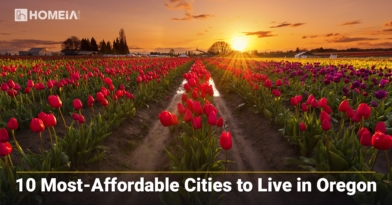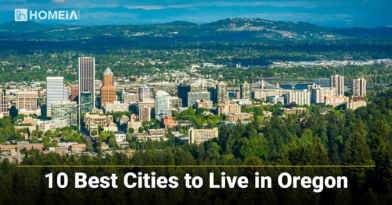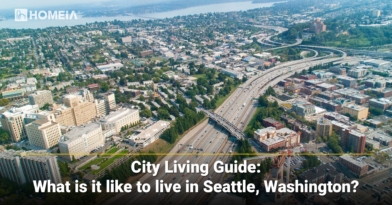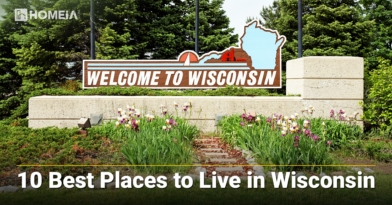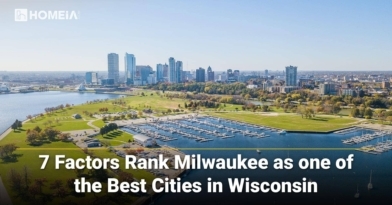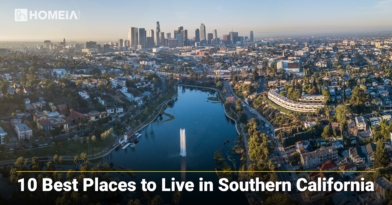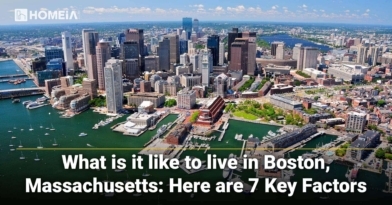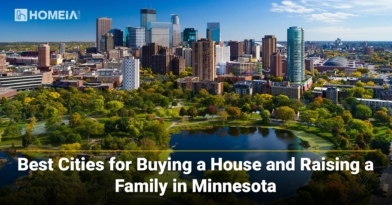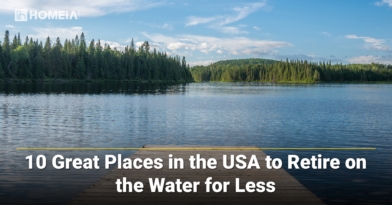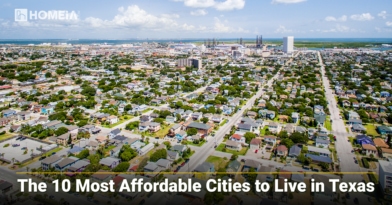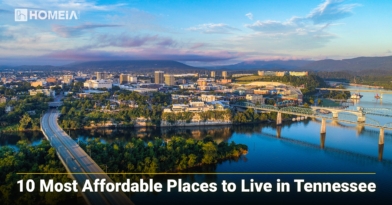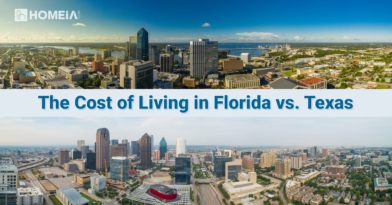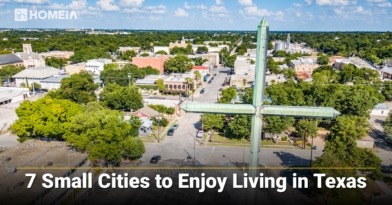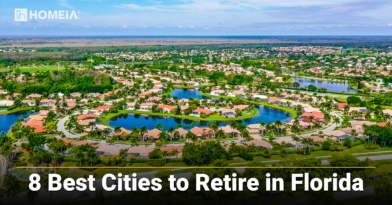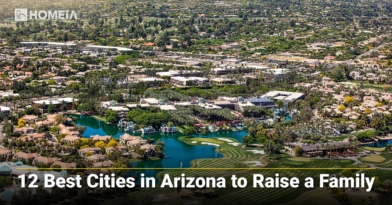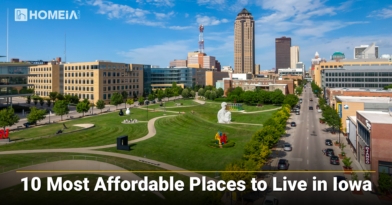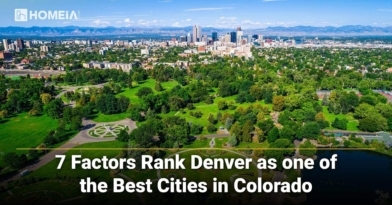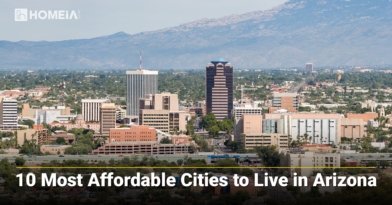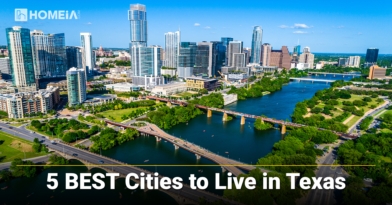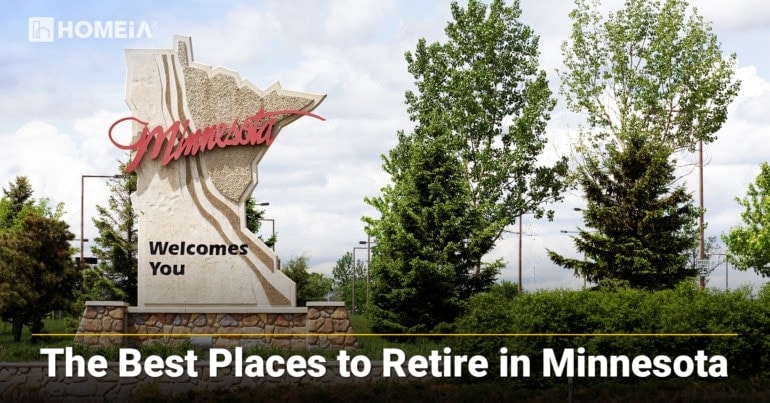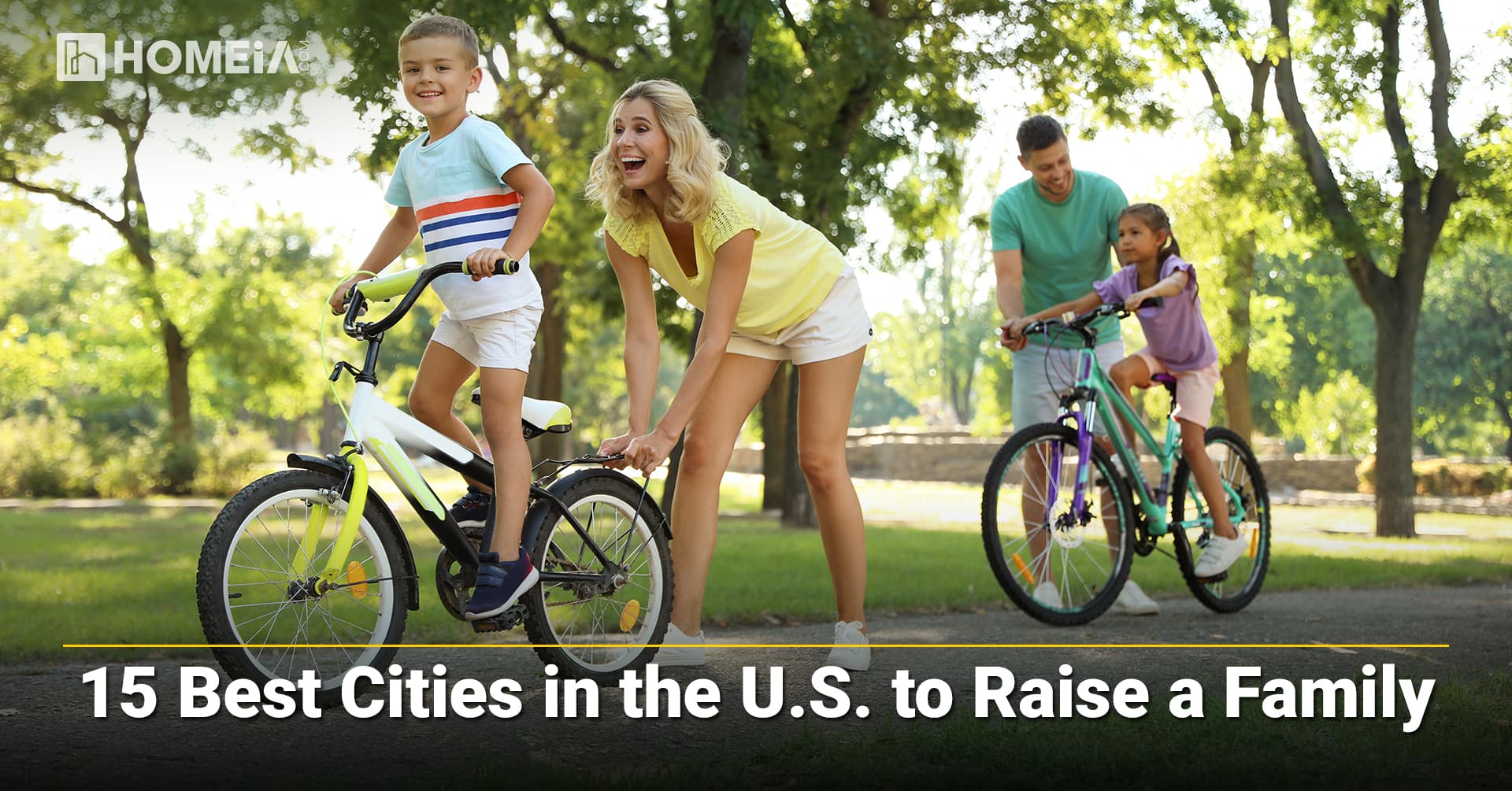10 Best Places to Live in Montana
- Author:by The HOMEiA Team
- Category: City Living Guide
Montana is an outdoor enthusiast’s paradise. Known as “Big Sky Country,” Montana is the fourth largest state in the United States, but with a population of just over a million, there is a lot of space to spread out.
While most of Montana is quite rural, there are several cities and towns that offer visitors and residents the best of both city living and access to outdoor activities. There are some common factors you should consider before moving to Montana. All of the communities described below have certain characteristics in common.
- 1. Taxes. Montana’s state income tax ranges from 1.0% to 6.75%, compared to the national average state income tax of 4.6%. There is no general sales tax in Montana, whereas the national average is 6.2%. Montana has one of the lower average effective property tax rates in the U.S. at 0.83%.
- 2. Climate. Most of Montana is brutally cold in the winter, but warm and pleasant in the summer. We will mention any specific climatic anomalies for specific areas if they exist.
Here are 10 best places to live in Montana.
Table of Contents:
1. Billings
HOMEiA Score: 97/100
- Population: 117,116 | Rank Last Year: #1
- Cost of Living: 7% below the U.S. national average
- Home price to income ratio: $221,100/$59,656 = 3.71 (buying homes is affordable)
- Income to rent ratio: $59,656/$10,788 = 5.53 (renting homes is very affordable)
Billings, the largest city in the state, is located in southern Montana where Interstate 90 meets Interstate 94. Billings Logan International Airport offers direct flights to hubs like Denver, Salt Lake City, Minneapolis, Seattle, Las Vegas, Phoenix and Dallas.
a. Size and Population
Billings has a population of 117,116 (2020) spread over a 44.72-square-mile area. The population density is 2,619 per square mile.
The population in Billings grew by 12.4% from April 2010 through April 2020, above both the overall U.S. rate of 7.4% and the Montana rate of 9.6%.
b. Median Income, Cost of Living and Housing Market Characteristics
The numbers below show the median income, cost of living and the annual spending on housing for owned and rented properties in Billings.
BILLINGS MEDIAN HOUSEHOLD INCOME (2019): $59,656
Billings Cost of Living
- 7% Lower than the U.S. National Average
- 25% Lower than Bozeman, Montana
- 50% Lower than New York City, New York
- 13% Lower than Chicago, Illinois
Billings Housing Costs
| Median Home Value | Annual Spend for Homeowners | Annual Spend for Renters (Rent & Utilities) |
| $221,100 | $17,088 | $10,788 |
Billings shows a home P/E (home price to income) ratio of 3.71, based on a median home value of $221,100 and a median household income of $59,656. The U.S. average is 3.46. Therefore, it is affordable to buy homes in the Billings area.
Billings shows an income to rent ratio of 5.53, based on a median household income of $59,656 and an annual spend of $10,788. Therefore, it is very affordable to rent properties in Billings.
In Billings, 63.0% of residents own their homes.
Pros and Cons of Living in Wyoming in 2024
Choosing to relocate can be quite overwhelming. Once you decide on a state, you still need to choose the right community. If you’ve decided to make Wyoming your new home, you’re in luck — it’s a big and varied place with something for all ages, family dynamics and budgets…
Top Neighborhoods in Billings, MT.
Billings’s relatively modest size means it doesn’t break down into distinct neighborhoods to the extent of a larger city. The majority of home values in Billings range from $75,000 to $600,000, though homes worth more $750,000 are not uncommon. Below are some characteristics of different parts of town.
- West End
The West End encompasses the entire western part of Billings and offers older and newer homes, access to public and private schools and a variety of shopping and dining options. - Yellowstone Country Club
Yellowstone is the area’s most prestigious country club and golf course. - Ironwood
A newer neighborhood with large lots and a variety of home sizes, Ironwood is located on the western edge of Billings. - Pioneer Park
Situated near downtown Billings, Pioneer Park is an established neighborhood with easy access to public schools and Montana State University Billings.
c. Employment Prospects
The unemployment rate in Billings is 2.8% (July 2021), which is below both the U.S. national rate of 4.8% and the Montana rate of 3.5%. The poverty rate, at 10.0%, is below both the national average of 11.4% and the Montana average of 12.6%.
The major employers in Billings include Talen Montana, Billings Clinic and First Interstate BancSystem.
The Billings area has an average commute time of 17.6 minutes.
d. Unique Attributes and Lifestyle
Billings, founded in 1877, is surrounded by sandstone cliffs known as the Rimrocks to the north and the Yellowstone River to the south. The city is steeped in western history with close proximity to attractions including:
- Pictograph Cave State Park. Prehistoric hunters camped at this site, which features three caves and over 100 pictographs, or rock paintings, which are over 2,000 years old.
- Little Bighorn Battlefield National Monument. Crazy Horse and Chief Gall led the Lakota, Northern Cheyenne and Arapaho to victory against the United States Army in the Great Sioux War of 1876.
- Pompey’s Pillar. Lewis and Clark left inscriptions on this sandstone outcrop on their expedition west.
In addition to historical attractions, Billings is well known for offering residents and visitors easy access to hiking, mountain biking, rafting, fishing and skiing.
10 Most Affordable Places to Live in Oregon
Geographically, Oregon boasts dramatic Pacific coastlines as well as volcanic mountain ranges. Its climate spans from rainforests along the coast to semi-arid conditions in the central and southeastern regions. The Beaver State is home to both Crater Lake, the deepest lake in the U.S., and Mount Hood, the second-most-climbed mountain in the world…
e. Education
There are 92 public schools and 49 private schools in the Billings area, based on data from GreatSchools. Among high schools, there are three public and six private schools.
Overall, the Billings area has an excellent educational infrastructure compared to similarly sized metro areas.
Prominent universities in the Billings area include Montana State University Billings, Yellowstone Christian College and Rocky Mountain College.
Over the 2015–2019 period, the high school graduation rate in Billings was above the U.S. national average of 88%. The population of adults above 25 years of age with a college degree was above the national average of approximately 32%.
f. Healthcare and Safety
Billings is well known for exceptional healthcare, with St. Vincent Healthcare and Billings Clinic providing services to residents of Montana, Wyoming and the western Dakotas.
Billings has 6.16 violent crimes per 1,000 residents, above Montana’s statewide median rate of 4.05 and the U.S. national median rate of 4.00. It has 41.60 property crimes per 1,000 residents, above Montana’s statewide median of 21.93 and the U.S. national median of 21.00.
Recommended for you
2. Bozeman
HOMEiA Score: 92/100
- Population: 53,293 | Rank Last Year: #2
- Cost of Living: 25% above the U.S. national average
- Home price to income ratio: $365,600/$55,569 = 6.58 (buying homes is expensive)
- Income to rent ratio: $55,569/$12,936 = 4.30 (renting homes is affordable)
Bozeman is located in southern Montana and is crossed by Interstate 90 from east to west. Bozeman Yellowstone International Airport, Montana’s busiest airport, offers direct flights to 30 markets across the United States.
a. Size and Population
Bozeman has a population of 53,293 (2020) spread over a 20.4-square-mile area. The population density is 2,612 per square mile.
The population in Bozeman grew by 43.0% from April 2010 through April 2020, substantially above both the overall U.S. rate of 7.4% and the Montana rate of 9.6%.
b. Median Income, Cost of Living and Housing Market Characteristics
The numbers below show the median income, cost of living and the annual spending on housing for owned and rented properties in Bozeman.
BOZEMAN MEDIAN HOUSEHOLD INCOME (2019): $55,569
Bozeman Cost of Living
- 25% Higher than the U.S. National Average
- 34% Higher than Billings, Montana
- 33% Lower than New York City, New York
- 17% Higher than Chicago, Illinois
Bozeman Housing Costs
| Median Home Value | Annual Spend for Homeowners | Annual Spend for Renters (Rent & Utilities) |
| $365,600 | $20,892 | $12,936 |
Bozeman shows a home P/E (home price to income) ratio of 6.58, based on a median home value of $365,600 and a median household income of $55,569. The U.S. average is 3.46. Therefore, it is expensive to buy homes in the Bozeman area.
Bozeman shows an income to rent ratio of 4.30, based on a median household income of $55,569 and an annual spend of $12,936. Therefore, it is affordable to rent properties in Bozeman.
In Bozeman, 43.1% of residents own their homes.
4 Best Places to Live in Minnesota for Families in 2024
Bordering Canada and the Great Lakes is a state fondly dubbed as the “North Star State” and “Land of 10,000 Lakes.” The state has a lot of lakes sprawled across its more than 86,000 square mile area. In a comprehensive study of cities, Minnesota is the number one state for raising a family because of its high median income, affordable cost of living and exceptional education services…
Top Neighborhoods in Bozeman, MT.
Bozeman’s relatively small size means it doesn’t break down into distinct neighborhoods to the extent of a larger city. The majority of home values in Bozeman range from $450,000 to $2 million, though homes worth substantially more than $2.5 million are not uncommon. Below are some characteristics of different parts of town.
- West Bozeman
West Bozeman is one of the fastest-growing parts of the city, with new construction and established subdivisions. The area is home to a 100-acre regional park and provides easy access to shopping, dining and schools. - South Side
The south side of Bozeman puts residents within 10 minutes of downtown but offers incredible mountain views at the same time. The area has always been highly sought after due to its close proximity to Montana State University. - Northeast Bozeman
Northeast Bozeman was a historically industrial part of town but has recently seen a surge in remodeling, which has created an eclectic mix of homes and unique businesses catering to young professionals and families. - Midtown
Residents looking for an urban vibe flock to Midtown for its newly constructed condos and mixed-use developments. - Outskirts of Bozeman
The outskirts of Bozeman provide more space and magnificent views for those wanting to live closer to the mountains and outdoor activities.
c. Employment Prospects
The unemployment rate in Bozeman is 2.0% (July 2021), which is substantially below both the U.S. national rate of 4.8% and the Montana rate of 3.5%. The poverty rate, at 17.8%, is above both the national average of 11.4% and the Montana average of 12.6%.
The major employers in Bozeman include Montana State University, Oracle and Workiva, along with several retail outlets such as Costco and Target.
The Bozeman area has an average commute time of 14.4 minutes.
d. Unique Attributes and Lifestyle
Bozeman, founded in 1864, is home to Montana State University and has historically been known as a college town. However, recently the city has seen an influx of residents moving from higher cost-of-living states due to its plethora of outdoor activities, which include skiing, hiking, rafting, hunting and fishing.
- Museum of the Rockies. This museum houses the largest collection of dinosaur remains in the United States and is home to the largest Tyrannosaurus skull ever found.
- Bridger Bowl Ski Area. Located just 16 miles north of Bozeman in the Bridger Range, Bridger Bowl has a summit elevation of 8,700 feet above sea level and offers skiing for a wide range of skill levels.
- Big Sky Resort. Big Sky is located midway between Bozeman and West Yellowstone, just off U.S. Highway 191. During winter, skiers can ride Lone Peak Tram to 11,166 feet above sea level for expert-level skiing and snowboarding. During summer, the area is popular for rafting, biking and fishing.
Top 10 Best Places to Live in Wyoming for Families
Wyoming is known for its big skies, open prairies and cowboy boots — yet it’s more than that. It reminds you that open space matters. In Wyoming, space is allotted for what’s essential, and the rest is left open for all to enjoy. It’s a place where you can relax, breathe in and breathe out…
e. Education
There are 20 public schools and 34 private schools in the Bozeman area, based on data from GreatSchools. Among high schools, there are 20 public and six private schools.
Overall, the Bozeman area has an excellent educational infrastructure compared to similarly sized metro areas.
Prominent universities in the Bozeman area include Montana State University and Gallatin College.
Over the 2015–2019 period, the high school graduation rate in Bozeman was substantially above the U.S. national average of 88%. The population of adults above 25 years of age with a college degree was substantially above the national average of approximately 32%.
f. Healthcare and Safety
Bozeman residents have access to many healthcare options, including Bozeman Health Deaconess Hospital and BDH Cancer Center. Despite Bozeman’s small population, Bozemanites have no shortage of quality healthcare services.
Bozeman has 2.61 violent crimes per 1,000 residents, below Montana’s statewide median rate of 4.05 and the U.S. national median rate of 4.00. It has 19.06 property crimes per 1,000 residents, below Montana’s statewide median of 21.93 and the U.S. national median of 21.00.
The 10 Best Places to Live in Oregon
Oregon is a study in contrasts. It has 363 miles of the most breathtaking coastline you’ll encounter anywhere in the world. But it also has dense forests, mountain ranges, and high desert country. Here’re the 10 Best Cities to Live in Oregon…
3. Missoula
HOMEiA Score: 88/100
- Population: 73,489 | Rank Last Year: #4
- Cost of Living: 12% above the U.S. national average
- Home price to income ratio: $279,700/$47,426 = 5.90 (buying homes is expensive)
- Income to rent ratio: $47,426/$10,308 = 4.60 (renting homes is affordable)
Missoula is located in western Montana, about 45 miles from the Idaho border, and is crossed by Interstate 90 from southeast to northwest. Missoula Montana Airport is a small airport offering direct flights to 16 markets across the United States.
a. Size and Population
Missoula has a population of 73,489 (2020) spread over a 34.66-square-mile area. The population density is 2,120 per square mile.
The population in Missoula grew by 10.0% from April 2010 through April 2020, above both the overall U.S. rate of 7.4% and the Montana rate of 9.6%.
b. Median Income, Cost of Living and Housing Market Characteristics
The numbers below show the median income, cost of living and the annual spending on housing for owned and rented properties in Missoula.
MISSOULA MEDIAN HOUSEHOLD INCOME (2019): $47,426
Missoula Cost of Living
- 12% Higher than the U.S. National Average
- 20% Higher than Billings, Montana
- 40% Lower than New York City, New York
- 5% Higher than Chicago, Illinois
Missoula Housing Costs
| Median Home Value | Annual Spend for Homeowners | Annual Spend for Renters (Rent & Utilities) |
| $279,700 | $19,440 | $10,308 |
Missoula shows a home P/E (home price to income) ratio of 5.90, based on a median home value of $279,700 and a median household income of $47,426. The U.S. average is 3.46. Therefore, it is expensive to buy homes in the Missoula area.
Missoula shows an income to rent ratio of 4.60, based on a median household income of $47,426 and an annual spend of $10,308. Therefore, it is affordable to rent properties in Missoula.
In Missoula, 47.4% of residents own their homes.
Recommended for you
Top Neighborhoods in Missoula, MT.
The best neighborhoods to live in Missoula include the ones listed below.
- Rose Park (Home Value Range $350,000 to $700,000)
Rose Park is a great community for walkers and bikers due to the reduced traffic in the area. At the center of the neighborhood is Rose Memorial Park, which is a great place to relax in the warmer weather. - Lewis and Clark (Home Value Range $400,000 to $800,000)
Lewis and Clark is centrally located and has easy access to great amenities, including parks and sports fields for summer fun and an ice rink for the winter. - Lower Rattlesnake (Home Value Range $550,000 to $725,000)
Lower Rattlesnake is perfect for those who want to be close to the outdoors. The Rattlesnake Recreation area nearby offers access to trails for day hikes.
c. Employment Prospects
The unemployment rate in Missoula is 2.8% (July 2021), which is below both the U.S. national rate of 4.8% and the Montana rate of 3.5%. The poverty rate, at 17.5%, is above both the national average of 11.4% and the Montana average of 12.6%.
The major employers in Missoula include the University of Montana, the City of Missoula, St. Patrick High School, Missoula County Public Schools and the U.S. Forest Service.
The Missoula area has an average commute time of 16.7 minutes.
d. Unique Attributes and Lifestyle
Missoula, founded in 1866, is home to the University of Montana and like its rival, Montana State University in Bozeman, has historically been known as a college town. Like many other cities and towns in Montana, it is known for outdoor activities, which include skiing, hiking, rafting, hunting, golfing and fishing.
Missoula is home to an eclectic mix of residents, including retirees, hippies, college students, loggers and football fans. This wide range of people means there is something for everyone.
- Breweries. Missoula is home to several popular breweries, including Big Sky Brewing, which is by far its most famous. Its best-selling beer is called Moose Drool Brown Ale. Big Sky Brewing is a great place to gather for a summer concert or go on a tour of the taproom.
- Parks. The city has almost 5,000 acres of conservation areas, 400 acres of parkland, and 22 miles of trails. All the open space, combined with Missoula’s location at the confluence of the Clark Fork, Bitterroot and Blackfoot Rivers, make for many opportunities to enjoy some rafting or fishing.
- Ski Resorts. Located just 20 minutes north of downtown Missoula, Snowbowl has a summit elevation of 7,600 feet above sea level and offers skiing for a wide range of skill levels. Within 100 miles of Missoula there are two other ski resorts as well: Discovery Ski Area and Lost Trail Powder Mountain, both easily reachable for a day or weekend trip.
What is It Like Living in Seattle, Washington?
Seattle is a beautiful port city on the Puget Sound in the northwestern U.S. state of Washington, 100 miles south of the Canadian border. As the largest city in the state (and the Pacific Northwest for that matter), Seattle is heavily endowed with natural resources. This hilly city earned…
e. Education
There are 22 public schools and 45 private schools in the Missoula area, based on data from GreatSchools. Among high schools, there are three public and three private schools.
Overall, the Missoula area has an excellent educational infrastructure compared to similarly sized metro areas.
Prominent universities in the Missoula area include the University of Montana and Missoula College.
Over the 2015–2019 period, the high school graduation rate in Missoula was substantially above the U.S. national average of 88%. The population of adults above 25 years of age with a college degree was above the national average of approximately 32%.
f. Healthcare and Safety
Missoula residents have access to many healthcare options, including Providence St. Patrick Hospital, which has been recognized as a Best Hospital in Montana by U.S. News & World Report.
Missoula has 4.11 violent crimes per 1,000 residents, above Montana’s statewide median rate of 4.05 and the U.S. national median rate of 4.00. It has 40.81 property crimes per 1,000 residents, above Montana’s statewide median of 21.93 and the U.S. national median of 21.00.
The 15 Best Places to Live & Retire in Minnesota
The cost of living in Minnesota varies by location and is highest in its large metro areas, but on the whole, it compares well to the coasts and to big cities. Each community in Minnesota has its own personality, and here we will introduce you to 15 of the best options for retiring in the North Star State…
4. Helena
HOMEiA Score: 89/100
- Population: 32,091 | Rank Last Year: #3
- Cost of Living: 1% below the U.S. national average
- Home price to income ratio: $244,300/$61,324 = 3.98 (buying homes is affordable)
- Income to rent ratio: $61,324/$9,840 = 6.23 (renting homes is very affordable)
Helena, the state capital, is located in western Montana and is crossed by Interstate 15 from north to south. Helena Regional Airport is a small airport offering direct flights to hubs like Denver, Salt Lake City and Seattle.
a. Size and Population
Helena has a population of 32,091 (2020) spread over a 16.86-square-mile area. The population density is 1,903 per square mile.
The population in Helena grew by 13.8% from April 2010 through April 2020, above both the overall U.S. rate of 7.4% and the Montana rate of 9.6%.
b. Median Income, Cost of Living and Housing Market Characteristics
The numbers below show the median income, cost of living and the annual spending on housing for owned and rented properties in Helena.
HELENA MEDIAN HOUSEHOLD INCOME (2019): $61,324
Helena Cost of Living
- 1% Lower than the U.S. National Average
- 6% Higher than Billings, Montana
- 47% Lower than New York City, New York
- 7% Lower than Chicago, Illinois
Helena Housing Costs
| Median Home Value | Annual Spend for Homeowners | Annual Spend for Renters (Rent & Utilities) |
| $244,300_ | $17,904 | $9,840 |
Helena shows a home P/E (home price to income) ratio of 3.98, based on a median home value of $244,300 and a median household income of $61,324. The U.S. average is 3.46. Therefore, it is affordable to buy homes in the Helena area.
Helena shows an income to rent ratio of 6.23, based on a median household income of $61,324 and an annual spend of $9,840. Therefore, it is very affordable to rent properties in Helena.
In Helena, 55.2% of residents own their homes.
Recommended for you
Top Neighborhoods in Helena, MT.
Helena’s small size means it doesn’t break down into distinct neighborhoods to the extent of a larger city. The majority of home values in Helena range from $250,000 to $600,000, though homes worth more $700,000 are not uncommon. Below are some characteristics of different parts of town.
- Central
Central is close to employment centers and amenities, making it ideal for singles, couples and young professionals. - Southeast
Southeast is great for those who want a little more space but still want to get downtown in under 20 minutes. - Euclid Avenue North
Euclid Avenue North is a top pick for professionals. It is only a 10-minute walk to downtown Helena and offers more affordable homes and rentals.
c. Employment Prospects
The unemployment rate in Helena is 3.6% (July 2021), which is below the U.S. national rate of 4.8% but just above the Montana rate of 3.5%. The poverty rate, at 13.7%, is above both the national average of 11.4% and the Montana average of 12.6%.
The major employer in Helena is the State of Montana. Other employers include HCL Technologies, Fast Enterprises, SoFi and Helena Public School.
The Helena area has an average commute time of 12.7 minutes.
d. Unique Attributes and Lifestyle
Helena was established in 1864 during the Montana gold rush. The gold rush created so much wealth that at one time there were more millionaires per capita in Helena than anywhere else in the world. This wealth helped develop the old Victorian neighborhoods in the city, but those aren’t the only attractions.
- Museums. Get a glimpse of Montana history with a tour of artifacts and art at the Montana Historical Society Museum.
- Outdoors. Day trips to the Missouri River, MacDonald Pass and the Gates of the Mountains are great for nature lovers who want to hike or fish.
- St. Helena Cathedral. This landmark cathedral was built in 1908 and modeled after a neo-Gothic church in Vienna, Austria.
10 Most Affordable Places to Live in Colorado
Given the outdoors benefits – the cost of living in Colorado is still one of the best values in the country. Here’re the 10 most affordable places to live in Colorado, taking into account the cost of living, median housing price, average crime rate and other factors that make the place unique…
e. Education
There are 15 public schools and 22 private schools in the Helena area, based on data from GreatSchools.org. Among high schools, there are two public and four private schools.
Overall, the Helena area has a good educational infrastructure compared to similarly sized metro areas.
Prominent universities in the Helena area include Carroll College and the University of Montana Helena College of Technology.
Over the 2015–2019 period, the high school graduation rate in Helena was substantially above the U.S. national average of 88%. The population of adults above 25 years of age with a college degree was above the national average of approximately 32%.
f. Healthcare and Safety
Helena residents have access to several healthcare options, including St. Peter’s Health, which has highly trained care teams at more than 20 specialty clinics throughout the city.
Helena has 5.74 violent crimes per 1,000 residents, above Montana’s statewide median rate of 4.05 and the U.S. national median rate of 4.00. It has 42.27 property crimes per 1,000 residents, significantly above Montana’s statewide median of 21.93 and the U.S. national median of 21.00.
10 Best Places to Live in Wisconsin
Wisconsin is a friendly and casual place to enjoy all four seasons. Best known for its dairy farms and pro sports, it is also home to tech companies and a world-class research university. We assign a HOMEiA Score for each city, which provides an overall assessment of its safety and appeal as a place to call home…
5. Great Falls
HOMEiA Score: 83/100
- Population: 60,442 | Rank Last Year: #9
- Cost of Living: 13% below the U.S. national average
- Home price to income ratio: $176,500/$46,965 = 3.76 (buying homes is affordable)
- Income to rent ratio: $46,495/$8,748 = 5.31 (renting homes is very affordable)
Great Falls is located in central Montana and is crossed by Interstate 15 from north to south. Great Falls International Airport offers direct flights to Denver, Las Vegas, Minneapolis, Phoenix, Salt Lake City and Seattle.
a. Size and Population
Great Falls has a population of 60,442 (2020) spread over a 23.45-square-mile area. The population density is 2,577 per square mile.
The population in Great Falls grew by 3.3% from April 2010 through April 2020, substantially below both the overall U.S. rate of 7.4% and the Montana rate of 9.6%.
b. Median Income, Cost of Living and Housing Market Characteristics
The numbers below show the median income, cost of living and the annual spending on housing for owned and rented properties in Great Falls.
GREAT FALLS MEDIAN HOUSEHOLD INCOME (2019): $46,965
Great Falls Cost of Living
- 13% Lower than the U.S. National Average
- 6% Lower than Billings, Montana
- 53% Lower than New York City, New York
- 18% Lower than Chicago, Illinois
Great Falls Housing Costs
| Median Home Value | Annual Spend for Homeowners | Annual Spend for Renters (Rent & Utilities) |
| $176,500 | $14,712 | $8,748 |
Great Falls shows a home P/E (home price to income) ratio of 3.46, based on a median home value of $176,500 and a median household income of $46,965. The U.S. average is 3.46. Therefore, it is affordable to buy homes in the Great Falls area.
Great Falls shows an income to rent ratio of 5.31, based on a median household income of $46,965 and an annual spend of $8,748. Therefore, it is very affordable to rent properties in Great Falls.
In Great Falls, 62.6% of residents own their homes.
7 Key Factors to Know About Living in Milwaukee, Wisconsin
If you want the variety, history, and entertainment options of a big city, but with shorter commutes and a laid-back Midwestern vibe, Milwaukee, Wisconsin may be the place for you. It has an upscale side, especially in trendy districts like the Historic Third Ward, and its proximity to Chicago…
Top Neighborhoods in Great Falls, MT.
Great Falls’s small size means it doesn’t break down into distinct neighborhoods to the extent of a larger city. The majority of home values in Great Falls range from $100,000 to $350,000, though homes worth more than $500,000 are not uncommon. Below are some characteristics of different parts of town.
- Belview Palisade
Belview Palisade is located on the west side of Great Falls, just over the Missouri River. The area offers large homes with views of the city. - Historic District
The Historic District is primarily located along Fourth Avenue North and features a number of homes built in the early 1900s. Homes include Arts and Crafts, Queen Anne and Colonial styles. - Gibson Flats
Gibson Flats is located just southeast of Great Falls but is considered part of the metropolitan area. Homes and homesites here are larger than in town, and the neighborhood offers close proximity to Malmstrom Air Force Base.
c. Employment Prospects
The unemployment rate in Great Falls is 3.0% (July 2021), which is below both the U.S. national rate of 4.8% and the Montana rate of 3.5%. The poverty rate, at 14.7%, is above both the national average of 11.4% and the Montana average of 12.6%.
The major employers in the Great Falls include the Benefits Health System, Great Falls Clinic and several retailers, including Albertsons and Walmart.
The Great Falls area has an average commute time of 14.4 minutes.
d. Unique Attributes and Lifestyle
Great Falls is named after a series of waterfalls on the Missouri River just northeast of the city. The area is rich in western history; Lewis and Clark passed through in 1805.
- Museums. The C.M. Russell Museum displays the rustic art of one of Montana’s most famous artists.
- Outdoors. Giant Springs State Park has one of the largest freshwater springs in the country and is a great place to hike or bike on more than 20 miles of trails.
- Entertainment. The Sip ’n Dip Tiki Lounge is famous for its mermaid show, which is a live underwater show viewable through the lounge’s window.
The 10 Most Affordable Places to Live in California in 2024
We assessed the cost of living across Californian cities and compared them to the national average. The cost of living is calculated based on 5 main categories: housing, food, healthcare, transportation and energy. Based on these calculations, we narrowed down the list to California’s 10 most affordable cities…
e. Education
There are 29 public schools and 50 private schools in the Great Falls area, based on data from GreatSchools. Among high schools, there are three public and 29 private schools.
Overall, the Great Falls area has a good educational infrastructure compared to similarly sized metro areas.
The Great Falls area has a number of universities and colleges, including the University of Great Falls and the Montana State University Great Falls College of Technology.
Over the 2015–2019 period, the high school graduation rate in Great Falls was above the U.S. national average of 88%. The population of adults above 25 years of age with a college degree was below the national average of approximately 32%.
f. Healthcare and Safety
Great Falls has several healthcare options, including the Great Falls Clinic Hospital and the Benefis Health System, which has five locations throughout the city.
Great Falls has 5.17 violent crimes per 1,000 residents, above Montana’s statewide median rate of 4.05 and the U.S. national median rate of 4.00. It has 58.27 property crimes per 1,000 residents, significantly above Montana’s statewide median of 21.93 and the U.S. national median of 21.00.
10 Best Places to Live in Southern California in 2024
HOMEiA is here to help you explore ten of the best places to live in Southern California. Each place has its own charm and unique qualities. Let’s take a quick dive into what Southern California has to offer! Here’re 10 best places to live in Southern California…
6. Kalispell
HOMEiA Score: 86/100
- Population: 24,558 | Rank Last Year: #6
- Cost of Living: 9% above the U.S. national average
- Home price to income ratio: $233,500/$50,294 = 4.64 (buying homes is expensive)
- Income to rent ratio: $50,294/$9,660 = 5.21 (renting homes is very affordable)
Kalispell is located in northwest Montana with convenient access to U.S. Highway 2 and U.S. Highway 93. The local airport is Glacier Park International Airport, which offers daily service to and from Denver, Salt Lake City, Minneapolis and Seattle. There are also seasonal direct flights to and from the West Coast, East Coast and Texas.
a. Size and Population
Kalispell has a population of 24,558 (2020) spread over a 12.5-square-mile area. The population density is 1,965 per square mile.
The population in Kalispell grew by 23.2% from April 2010 through April 2020, substantially above both the overall U.S. rate of 7.4% and the Montana rate of 9.6%.
b. Median Income, Cost of Living and Housing Market Characteristics
The numbers below show the median income, cost of living and the annual spending on housing for owned and rented properties in Kalispell.
KALISPELL MEDIAN HOUSEHOLD INCOME (2019): $50,294
Kalispell Cost of Living
- 9% Higher than the U.S. National Average
- 3% Lower than Missoula, Montana
- 42% Lower than New York City, New York
- 2% Higher than Chicago, Illinois
Kalispell Housing Costs
| Median Home Value | Annual Spend for Homeowners | Annual Spend for Renters (Rent & Utilities) |
| $233,500 | $16,032 | $9,660 |
Kalispell shows a home P/E (home price to income) ratio of 4.64, based on a median home value of $233,500 and a median household income of $50,294. The U.S. average is 3.46. Therefore, it is expensive to buy homes in the Kalispell area.
Kalispell shows an income to rent ratio of 5.21, based on a median household income of $50,294 and an annual spend of $9,660. Therefore, it is very affordable to rent properties in Kalispell.
In Kalispell, 60.4% of residents own their homes.
7 Key Factors to Know About Living in Boston in 2024
Before considering your move to Boston, we have compiled a list of 7 key factors we put together for you. Boston life is about the best city life you can imagine. Relatively small, it’s often referred to as the walking city, with world-class museums, universities, theaters, and gourmet dining…
Top Neighborhoods in Kalispell, MT.
Kalispell’s relatively small size means it doesn’t break down into distinct neighborhoods to the extent of a larger city. The majority of home values in Kalispell range from $300,000 to $800,000, though homes worth more $1 million are not uncommon. Below are some characteristics of different parts of town.
- Glacier Commons
Glacier Commons is close to shopping, restaurants, golf courses and schools. - East Side
East Side is a walkable community close to downtown featuring tree-lined streets and older Craftsman-style homes. - Stillwater Estates
This neighborhood offers newer homes on larger lots. It is located in northwest Kalispell and has great views of the valley. - Northern Pines
Northern Pines is a golf course community featuring an 18-hole championship course. It is a quick drive from Northern Pines into Kalispell.
c. Employment Prospects
The unemployment rate in Kalispell is 3.1% (July 2021), which is below both the U.S. national rate of 4.8% and the Montana rate of 3.5%. The poverty rate, at 13.3%, is above both the national average of 11.4% and the Montana average of 12.6%.
The major employers in Kalispell include the Kalispell Regional Medical Center, Weyerhaeuser, Health Center Northwest and Applied Materials/Semitool.
The Kalispell area has an average commute time of 15.0 minutes.
d. Unique Attributes and Lifestyle
Kalispell is the largest city in northwest Montana and is the gateway to Glacier National Park and other attractions in the area.
- Outdoors. Glacier National Park is just 31 miles away, Whitefish Mountain Resort is 17 miles and Flathead Lake is only seven miles. At any time of year, there is something for everyone who wants to get outside.
- Entertainment. The Kalispell area offers several golf courses and museums.
- Food. A visit to northwest Montana is not complete without a slice of huckleberry pie or a scoop of huckleberry ice cream. Both can be found in Kalispell, but a pit stop in Hungry Horse on the way to Glacier Park never disappoints.
8 Best Cities for Buying a House and Raising a Family in Minnesota
While everyone in Minnesota shares accesses to the great outdoors, four distinctly enjoyable seasons, and a friendly Midwestern vibe, each community has its own personality. Here are our views of the Top 8 Cities for family life in Minnesota. With a variety of personalities and attractions…
e. Education
There are 22 public schools and 44 private schools in the Kalispell area, based on data from GreatSchools. Among high schools, there are two public and three private schools.
Overall, the Kalispell area has a good educational infrastructure compared to similarly sized metro areas.
The Kalispell area does not have many prominent universities, though Montana State is nearby, and residents can avail themselves of Kalispell Community College.
Over the 2015–2019 period, the high school graduation rate in Kalispell was above the U.S. national average of 88%. The population of adults above 25 years of age with a college degree was below the national average of approximately 32%.
f. Healthcare and Safety
Kalispell is home to Logan Health, formerly known as Kalispell Regional Healthcare. This system includes a large medical center and several specialty clinics throughout the city.
Kalispell has 4.15 violent crimes per 1,000 residents, above Montana’s statewide median rate of 4.05 and the U.S. national median rate of 4.00. It has 33.42 property crimes per 1,000 residents, above Montana’s statewide median of 21.93 and the U.S. national median of 21.00.
12 Key Factors to Know About Living in Washington, D.C.
The capital city of the United States has a reputation for being a busy political and business hub, but there is a lot more to discover and enjoy for residents of this diverse city. Washington, DC is consistently ranked among Business Insider’s and Niche’s top 50 cities to live in, and there are…
7. Bigfork
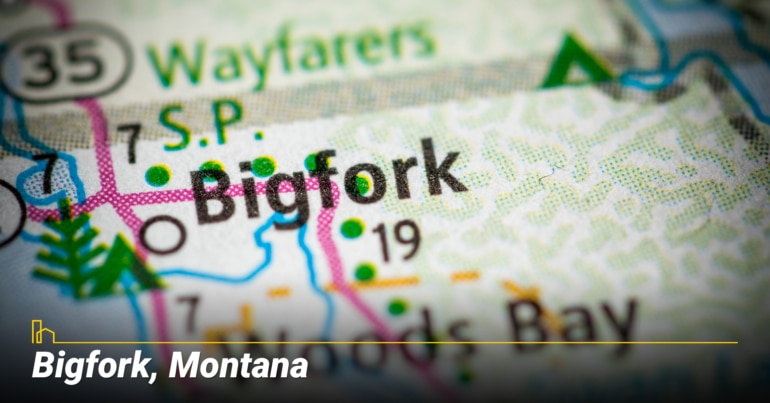
HOMEiA Score: 85/100
- Population: 5,118 | Rank Last Year: #7
- Cost of Living: 23% above the U.S. national average.
- Home price to income ratio: $365,300/$60,076 = 6.08 (buying homes is expensive)
- Income to rent ratio: $60,076/$10,608 = 5.66 (renting homes is very affordable)
Bigfork is located on the north end of Flathead Lake in northwest Montana, just a 25-minute drive from Kalispell. The closest airport is Glacier Park International Airport, which offers daily service to and from Denver, Salt Lake City, Minneapolis and Seattle. There are also seasonal direct flights to and from the West Coast, East Coast and Texas.
a. Size and Population
Bigfork has a population of 5,118 (2020) spread over a 37.3-square-mile area. The population density is 137 per square mile.
The population in Bigfork grew by 19.9% from April 2010 through April 2020, substantially above both the overall U.S. rate of 7.4% and the Montana rate of 9.6%.
b. Median Income, Cost of Living and Housing Market Characteristics
The numbers below show the median income, cost of living and the annual spending on housing for owned and rented properties in Bigfork.
BIGFORK MEDIAN HOUSEHOLD INCOME (2019): $60,076
Bigfork Cost of Living
- 23% Higher than the U.S. National Average
- 9% Higher than Missoula, Montana
- 35% Lower than New York City, New York
- 15% Higher than Chicago, Illinois
Bigfork Housing Costs
| Median Home Value | Annual Spend for Homeowners | Annual Spend for Renters (Rent & Utilities) |
| $365,300 | $19,632 | $10,608 |
Bigfork shows a home P/E (home price to income) ratio of 6.08, based on a median home value of $365,300 and a median household income of $60,076. The U.S. average is 3.46. Therefore, it is expensive to buy homes in the Bigfork area.
Bigfork shows an income to rent ratio of 5.66, based on a median household income of $60,076 and an annual spend of $10,608. Therefore, it is very affordable to rent properties in Bigfork.
In Bigfork, 75.4% of residents own their homes.
The 10 Best Places in the USA to Retire on the Water for Less
The popularity of the waterfront can mean high housing costs and consumer prices. Luckily, for those willing to look past the likes of Malibu and Venice Beach, there are plenty of scenic spots along the country’s lakes and oceans where retirees can make a nice home even with a reduced…
Top Neighborhoods in Bigfork, MT.
Bigfork’s small size means it doesn’t break down into distinct neighborhoods to the extent of a larger city. The majority of home values in Bigfork range from $250,000 to $2 million, though homes worth substantially more than $2.5 million are not uncommon. Below are some characteristics of different parts of town.
- Harbor Village
Located in the Eagle Bend Golf Community, Harbor Village provides residents with access to a 27-hole championship golf course. It also offers river access. - Bigfork Harbor
Bigfork Harbor is a condo complex located on the mouth of the Swan River, right on Bigfork Bay. - Bigfork Landing
Bigfork Landing is a newer community located along the Eagle Bend Golf Community and across the street from Flathead Lake. Homes here feature great mountain and lake views. - Stage Ridge
This neighborhood is located on the north side of Bigfork and provides quick access to downtown and schools.
c. Employment Prospects
The unemployment rate in Bigfork is 5.6% (July 2021), which is above both the U.S. national rate of 4.8% and the Montana rate of 3.5%. The poverty rate, at 12.3%, is above the national average of 11.4% and below the Montana average of 12.6%.
The major employers in Bigfork include the State of Montana, Applied Materials, TTEC and a number of retailers, including the Home Depot.
The Bigfork area has an average commute time of 21.0 minutes.
d. Unique Attributes and Lifestyle
Bigfork’s location on the north shore of Flathead Lake makes this small community the perfect place to get out on the water, but that is not all it has to offer.
- Outdoors. Glacier Park is easily accessible with a 45-minute drive, but even closer there are opportunities for hunting, fishing, camping, biking, trekking, boating, skiing and golfing.
- Entertainment. Brewfest, farmer’s markets, Riverbend summer concerts, film festivals, and the annual Fourth of July Parade bring people from all over the state.
- Food. Despite the small size of the town, Bigfork restaurants offer some of the best dining in the Flathead Valley. Not only is there everything from casual dining to international cuisine, but restaurants also feature local favorites like elk, bison and huckleberries.
The 10 Cheapest Places to Live in Texas
They say everything is bigger in Texas, and for good reason. From some of America’s largest and active metropolitan cities to the host of recreational activities for people of all ages across the state to the many bigger-than-life personalities who call Texas home, Texas has plenty to offer for everyone. here’s the list of 10 lowest cost of living places…
e. Education
Bigfork is served by the Bigfork Elementary School District and Bigfork High School.
Overall, the Bigfork area has a good educational infrastructure compared to similarly sized metro areas.
There are no prominent universities or colleges in Bigfork, though Montana State and Flathead Valley Community College are nearby.
Over the 2015–2019 period, the high school graduation rate in Bigfork was above the U.S. national average of 88%. The population of adults above 25 years of age with a college degree was above the national average of approximately 32%.
f. Healthcare and Safety
Bigfork has several healthcare options, including primary care facilities and physical therapy; however, for more advanced care and procedures, Kalispell is a better option.
Bigfork has 1.83 violent crimes per 1,000 residents, below Montana’s statewide median rate of 4.05 and the U.S. national median rate of 4.00. It has 8.00 property crimes per 1,000 residents, below Montana’s statewide median of 21.93 and the U.S. national median of 21.00.
10 Most Affordable Places to Live in Tennessee in 2024
Travel aficionados who are looking to fill up their bucket list with various visits to fun U.S. states should most definitely pencil in Tennessee as one of their destinations. The people in the so-called Volunteer State (Go Vols!) are genuinely friendly folks who never fail to provide visitors with…
8. Whitefish
HOMEiA Score: 84/100
- Population: 7,751 | Rank Last Year: #8
- Cost of Living: 28% above the U.S. national average.
- Home price to income ratio: $364,500/$52,037 = 7.00 (buying homes is expensive)
- Income to rent ratio: $52,037/$12,168 = 4.28 (renting homes is affordable)
Whitefish is located in northwest Montana, just a 25-minute drive north of Kalispell. The closest airport is Glacier Park International Airport, which offers daily service to and from Denver, Salt Lake City, Minneapolis and Seattle. There are also seasonal direct flights to and from the West Coast, East Coast and Texas.
a. Size and Population
Whitefish has a population of 7,751 (2020) spread over a 12.32-square-mile area. The population density is 629 per square mile.
The population in Whitefish grew by 21.9% from April 2010 through April 2020, substantially above both the overall U.S. rate of 7.4% and the Montana rate of 9.6%.
b. Median Income, Cost of Living and Housing Market Characteristics
The numbers below show the median income, cost of living and the annual spending on housing for owned and rented properties in Whitefish.
WHITEFISH MEDIAN HOUSEHOLD INCOME (2019): $52,037
Whitefish Cost of Living
- 28% Higher than the U.S. National Average
- 14% Higher than Missoula, Montana
- 32% Lower than New York City, New York
- 19% Higher than Chicago, Illinois
Whitefish Housing Costs
| Median Home Value | Annual Spend for Homeowners | Annual Spend for Renters (Rent & Utilities) |
| $364,500 | $17,748 | $12,168 |
Whitefish shows a home P/E (home price to income) ratio of 7.00, based on a median home value of $364,500 and a median household income of $52,037. The U.S. average is 3.46. Therefore, it is expensive to buy homes in the Whitefish area.
Whitefish shows an income to rent ratio of 4.28, based on a median household income of $52,037 and an annual spend of $12,168. Therefore, it is affordable to rent properties in Whitefish.
In Whitefish, 58.0% of residents own their homes.
The Cost of Living in Florida vs. Texas
Texas and Florida are vast and have hundreds of communities to choose from. But what are the pros and cons of living in each state? Come with HOMEiA as we explore 7 crucial factors that reveal the true costs of choosing Florida or Texas as your new home…
Top Neighborhoods in Whitefish, MT.
Whitefish’s small size means it doesn’t break down into distinct neighborhoods to the extent of a larger city. The majority of home values in Whitefish range from $300,000 to $1.5 million, though homes worth more than $2 million are not uncommon. Below are some characteristics of different parts of town.
- Creekwood
Creekwood is a highly sought-after neighborhood due to its close proximity to schools and mountain views. - Iron Horse
Iron Horse is a high-end Tom Fazio–designed golf community located near Whitefish Mountain Resort. - The Avenues
The Avenues is a very desirable community due to its walkability and close proximity to shopping and dining downtown. - City Beach
This neighborhood has direct access to the famous sandy beach on Whitefish Lake. There are also a public boat dock and access to bike paths.
c. Employment Prospects
The unemployment rate in Whitefish is 5.6% (July 2021), which is above both the U.S. national rate of 4.8% and the Montana rate of 3.5%. The poverty rate, at 7.6%, is below both the national average of 11.4% and the Montana average of 12.6%.
The major employers in the Whitefish area include Applied Materials, Express Employment Professionals, Pursuit Collections and TTEC.
The Whitefish area has an average commute time of 17.3 minutes.
d. Unique Attributes and Lifestyle
Whitefish is a resort town located on the banks of Whitefish Lake, which is famous for its sandy beach. The small town is a gateway to Glacier National Park, Whitefish Mountain Resort and many other area attractions.
- Outdoors. Glacier Park is not far at just a 35-minute drive and Whitefish Mountain Resort is even closer at only 15 minutes. Visitors and residents enjoy hunting, fishing, camping, biking, zip lining, boating, skiing and golfing.
- Entertainment. The eclectic downtown offers charming streets lined with shops and boutiques.
- Food. Many dining options to cater to tourists and residents alike with everything from a hearty mountain breakfast to fine dining in the evening.
15 Best Cities for Families in Texas
There are many employment opportunities throughout the state and many enjoyable communities to call home. We’ve compiled a list of 15 cities that rank high in education, affordability, and safety—areas of interest for many potential homeowners…
Education
There are six public schools and four private schools in the Whitefish area, based on data from GreatSchools.org. There is one public high school, and there are no private high schools.
Overall, the Whitefish area has a good educational infrastructure compared to similarly sized metro areas.
Universities close to the Whitefish area include Flathead Valley Community College and Montana State.
Over the 2015–2019 period, the high school graduation rate in Whitefish was substantially above the U.S. national average of 88%. The population of adults above 25 years of age with a college degree was substantially above the national average of approximately 32%.
f. Healthcare and Safety
Logan Health – Whitefish (formerly North Valley Hospital) is the only hospital in Whitefish, but it does offer many services, including an emergency room, minimally invasive surgeries and a sleep medicine center, among others.
Whitefish has 1.21 violent crimes per 1,000 residents, below Montana’s statewide median rate of 4.05 and the U.S. national median rate of 4.00. It has 14.59 property crimes per 1,000 residents, below Montana’s statewide median of 21.93 and the U.S. national median of 21.00.
7 Best Small Towns to Live in Texas
We present 7 smaller cities that are great for professionals, retirees, and families with children. Incidentally, they also happen to be places that I have enjoyed visiting with family and friends over the decades. In our examination, we’ll prioritize things that may be more important for families who prefer not to live in heavily urbanized areas…
9. Polson
HOMEiA Score: 79/100
- Population: 5,148 | Rank Last Year: #10
- Cost of Living: On par with the U.S. national average
- Home price to income ratio: $187,200/$37,054 = 5.05 (buying homes is expensive)
- Income to rent ratio: $37,054/$8,724 = 4.25 (renting homes is affordable)
Polson is located on the south end of Flathead Lake in northwest Montana about a 60-minute drive from Kalispell. The closest airports are Glacier Park International Airport and Missoula International Airport.
a. Size and Population
Polsonhas a population of 5,148 (2020) spread over a 4.7-square-mile area. The population density is 1,095 per square mile.
The population in Polson grew by 14.7% from April 2010 through April 2020, substantially above both the overall U.S. rate of 7.4% and the Montana rate of 9.6%.
b. Median Income, Cost of Living and Housing Market Characteristics
The numbers below show the median income, cost of living and the annual spending on housing for owned and rented properties in Polson.
POLSON MEDIAN HOUSEHOLD INCOME (2019): $37,054
Polson Cost of Living
- On Par with the U.S. National Average
- 11% Lower than Missoula, Montana
- 47% Lower than New York City, New York
- 7% Lower than Chicago, Illinois
Polson Housing Costs
| Median Home Value | Annual Spend for Homeowners | Annual Spend for Renters (Rent & Utilities) |
| $187,200 | $16,116 | $8,724 |
Polson shows a home P/E (home price to income) ratio of 5.05, based on a median home value of $187,200 and a median household income of $37,054. The U.S. average is 3.46. Therefore, it is expensive to buy homes in the Polson area.
Polson shows an income to rent ratio of 4.25, based on a median household income of $37,054 and an annual spend of $8,734. Therefore, it is affordable to rent properties in Polson.
In Polson, 55% of residents own their homes.
The 8 Best Places to Live in Florida For Retirees in 2024
We have presented options that will fit different budgets and needs – there should be a choice for everyone. We have listed the most affordable cities first, though the ranks and index scores are assigned based on a larger set of characteristics that we have reviewed…
Top Neighborhoods in Polson, MT.
Polson’s small size means it doesn’t break down into distinct neighborhoods to the extent of a larger city. The majority of home values in Polson range from $200,000 to $750,000, though homes worth substantially more than $1 million are not uncommon. Below are some characteristics of different parts of town.
- In-town Polson
The majority of homes within Polson are single-story and modestly sized. Polson is more affordable than other towns on Flathead Lake. - Lakefront and Surrounding Areas
The lakefront and surrounding areas just outside of Polson offer larger lots and more expansive homes. Prices increase depending on proximity to the lake.
c. Employment Prospects
The unemployment rate in Polson is 5.0% (July 2021), which is above both the U.S. national rate of 4.8% and the Montana rate of 3.5%. The poverty rate, at 19.3%, is above both the national average of 11.4% and the Montana average of 12.6%.
Some of the major employers in the Polson area include T-Mobile, Veterans of Foreign Wars, M&S Meats and the Arlee Rehabilitation Center.
The Polson area has an average commute time of 13.9 minutes.
d. Unique Attributes and Lifestyle
Polson is a small town on the south end of Flathead Lake. It is on the Flathead Indian Reservation, which is home to the Confederated Salish and Kootenai Tribes. Life in Polson revolves around outdoor adventures, due to its location on the lake.
- Boating. Flathead Lake is the largest natural freshwater lake in the western United States, making it great for boating enthusiasts. There are several rental companies that provide powerboats, pontoon boats and Jet Skis. For a slower-paced adventure, kayaking and paddle boarding are also popular.
- Entertainment. The Flathead Lake Cherry Festival in July is a great way to taste a variety of the famous cherry products that are so well known in the area.
12 Best Cities to Live in Arizona for Families
We took 4 main variables into consideration to determine the best places in Arizona to raise a family. The variables are quality of education, health care, personal safety, and recreational opportunities. Here you’ll find our list, along with the highlights that make each Arizona locale a special place to raise a family…
e. Education
There are five public schools and three private schools in the Polson area, based on data from GreatSchools. There are two high schools: one public and one private.
Overall, the Polson area has a good educational infrastructure compared to similarly sized metro areas.
There are no prominent universities and colleges in the Polson area. Those close by include Flathead Valley Community College, Salish Kootenai College and Montana State.
Over the 2015–2019 period, the high school graduation rate in Polson was above the U.S. national average of 88%. The population of adults above 25 years of age with a college degree was below the national average of approximately 32%.
f. Healthcare and Safety
Polson is home to Providence St. Joseph Medical Center, which offers emergency services, a birthing center, heart and vascular care and joint replacement. For more specialized services, Kalispell and Missoula both have more to offer.
Polson has 5.14 violent crimes per 1,000 residents, above Montana’s statewide median rate of 4.05 and the U.S. national median rate of 4.00. It has 38.93 property crimes per 1,000 residents, above Montana’s statewide median of 21.93 and the U.S. national median of 21.00.
10 Most Affordable Places to Live in Iowa
We started with the top 30 towns in Iowa by population—those with at least 15,000 residents. Then we ruled out those whose populations had fallen over the last 10 years, using population growth as a proxy measure for desirability. Finally, we chose those with the lowest median list price for homes…
10. Livingston
HOMEiA Score: 86/100
- Population: 8,040 | Rank Last Year: #5
- Cost of Living: 3% above the U.S. national average
- Home price to income ratio: $224,200/$46,097 = 4.86 (buying homes is expensive)
- Income to rent ratio: $46,097/$9,756 = 4.72 (renting homes is affordable)
Livingston is located in southwestern Montana and is crossed by Interstate 90 from east to west. The closest major airport is Bozeman Yellowstone International Airport, which is about 30 minutes west by car and is Montana’s busiest airport, offering direct flights to 30 markets across the United States.
a. Size and Population
Livingston has a population of 8,040 (2020) spread over a 5.7-square-mile area. The population density is 1,411 per square mile.
The population in Livingston grew by 14.1% from April 2010 through April 2020, above both the overall U.S. rate of 7.4% and the Montana rate of 9.6%.
b. Median Income, Cost of Living and Housing Market Characteristics
The numbers below show the median income, cost of living and the annual spending on housing for owned and rented properties in Livingston.
LIVINGSTON MEDIAN HOUSEHOLD INCOME (2019): $46,097
Livingston Cost of Living
- 3% Higher than the U.S. National Average
- 10% Higher than Billings, Montana
- 45% Lower than New York City, New York
- 4% Lower than Chicago, Illinois
Livingston Housing Costs
| Median Home Value | Annual Spend for Homeowners | Annual Spend for Renters (Rent & Utilities) |
| $224,200 | $15,804 | $9,756 |
Livingston shows a home P/E (home price to income) ratio of 4.86, based on a median home value of $224,200 and a median household income of $46,097. The U.S. average is 3.46. Therefore, it is expensive to buy homes in the Livingston area.
Livingston shows an income to rent ratio of 4.72, based on a median household income of $46,097 and an annual spend of $9,756. Therefore, it is affordable to rent properties in Livingston.
In Livingston, 65.0% of residents own their homes.
7 Key Factors To Know About Living in Denver, Colorado
The Denver area is growing in population much faster than most of the country, increasing by almost 20% from 2010 to 2018. It’s no wonder; it rates as the second-best place to live in the United States, according to U.S. News & World Report (2019). Here’re 7 key factors you should know Before living in Denver Colorado…
Top Neighborhoods in Livingston, MT.
Livingston’s small size means it doesn’t break down into distinct neighborhoods to the extent of a larger city. The majority of home values in Livingston range from $250,000 to $750,000, though homes worth more than $1 million are not uncommon. Below are some characteristics of different parts of town.
- In-town Livingston
Inside the town of Livingston there are a range of home types, from condos to single-family homes. These homes are typically smaller, older homes on smaller lots. - Outskirts of Livingston
The outskirts of Livingston are where larger homesites and ranches can be found. Living on the outskirts is popular with those seeking some seclusion or quick access to outdoor activities.
c. Employment Prospects
The unemployment rate in Livingston is 3.5% (July 2021), which is below the U.S. national rate of 4.8% and on par with the Montana rate of 3.5%. The poverty rate, at 14.5%, is above both the national average of 11.4% and the Montana average of 12.6%.
Some of the major employers in the Livingston area include the State of Montana, the University of Montana, Montana State University, Workiva, Oracle and the U.S. Air Force.
The Livingston area has an average commute time of 21.1 minutes.
d. Unique Attributes and Lifestyle
Livingston was incorporated in 1882 and was originally a small railroad and ranching town. Since then, this windy town has become a popular retreat for celebrities seeking some peace and quiet.
Livingston is a classic Montana town surrounded by the beautiful snow-capped Absaroka, Crazy and Gallatin Mountain Ranges. Most notably, however, Livingston is the gateway to Yellowstone National Park and other great area attractions.
- Yellowstone National Park. Livingston offers easy access to Yellowstone National Park, which was America’s first national park. From Livingston, visitors can travel south via U.S. Highway 89 for about an hour and enter the park through Mammoth Hot Springs. Mammoth Hot Springs is home to a natural complex of hot springs. Herds of elk can be seen roaming throughout the small town.
- Chico Hot Springs. Located just 25 miles south of Livingston in Pray, Montana, Chico Hot Springs is a natural hot spring that was turned into a resort and is popular for short vacations and destination weddings.
- Fly Fishing. Livingston is the ideal starting point for a guided fly fishing expedition along the Yellowstone River and other area creeks and streams in Paradise Valley.
The 10 Most Affordable Places to Live in Arizona
Arizona is world-renowned for its dramatic beauty, a combination of rugged mountains and vast desert landscapes. The sixth-largest state by area and the 14th largest in terms of population, Arizona is indeed beautiful–but it’s much, much more than that…
e. Education
There are six public schools and six private schools in the Livingston area, based on data from GreatSchools.org. There is one public high school, and there are no private schools.
Overall, the Livingston area has a good educational infrastructure compared to similarly sized metro areas.
There are no prominent universities and colleges in the Polson area. Those close by include Montana State University and Gallatin College.
Over the 2015–2019 period, the high school graduation rate in Livingston was above the U.S. national average of 88%. The population of adults above 25 years of age with a college degree was below the national average of approximately 32%.
f. Healthcare and Safety
Livingston residents and visitors have access to several healthcare options in town, including Livingston HealthCare, which is a Billings Clinic Affiliate. More specialized care options can be found about 30 minutes west in Bozeman or 90 minutes east in Billings.
Livingston has 6.54 violent crimes per 1,000 residents, above Montana’s statewide median rate of 4.05 and the U.S. national median rate of 4.00. It has 23.97 property crimes per 1,000 residents, above Montana’s statewide median of 21.93 and the U.S. national median of 21.00.
CONCLUSION
Montana is well known for its wide-open spaces and outdoor activities. Due to its extremely cold winters and warm summers, it is a great place for residents and visitors who enjoy a variety of outdoor sports, like skiing, hunting, fishing and hiking.
5 Best Places to Live in Texas
Each of the five large cities described are chock-full of neighborhoods that are favored by families with children, young professionals, and retirees. We’ll focus on eight critical attributes that often define a city: History and population, Lifestyle, Affordability, Housing market and neighborhoods, Healthcare and safety, Employment…

